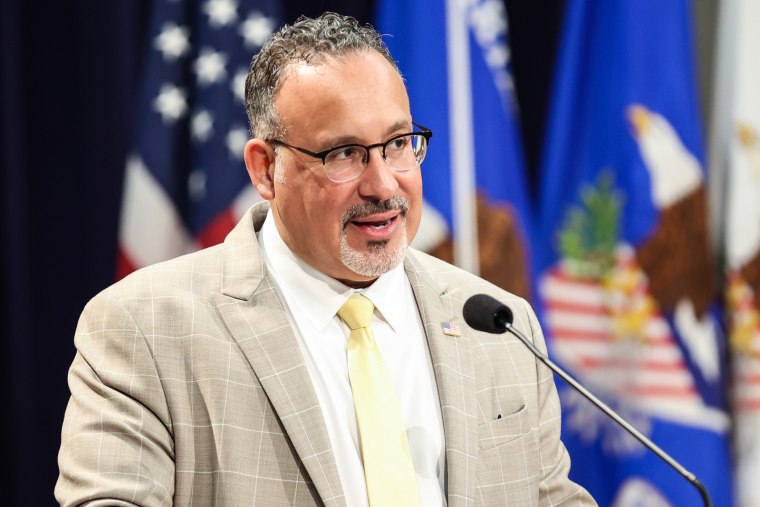The Education Department is assuring schools and students that its financial aid process will be fixed after a botched overhaul led some colleges to say they were seeing decreased enrollments.
Education Secretary Miguel Cardona said he’s “very confident” households will be able to start applying for federal financial aid by Dec. 1, just weeks after officials pushed back the launch date for the Free Application for Federal Student Aid (FAFSA) by two months to Dec. 1 for the 2025-26 academic year.
The move aims to buy more time to test the online form with select students and schools after months of glitches and delays roiled the college application process for millions of students this year.
“We’ve got to do better, and we’re going to do better,” Cardona told NBC News this week. Going forward, the application experience is “going to be simpler — 15, 20 minutes,” he promised.
Get top local stories in Southern California delivered to you every morning. Sign up for NBC LA's News Headlines newsletter.
Already, fallout from the months of snags is showing up in enrollments, many higher-education officials say.

About three-quarters of the 384 private institutions that responded to a recent survey by the National Association of Independent Colleges and Universities said FAFSA issues altered the makeup of incoming freshman classes.
U.S. & World
News from around the country and around the globe
Forty-three percent said their first-year cohort is smaller than the prior one, according to a summary of findings NAICU released from the July leg of the survey, which it plans to continue conducting through September. The 850-school association told NBC News that 18% of respondents reported FAFSA problems have reduced the racial or ethnic diversity of freshman classes, and 27% said they logged fewer financial aid recipients.
The Education Department recognizes that this year’s FAFSA rollout “has been challenging for students, families, and postsecondary institutions,” a spokesperson said in response to the findings, but added that the agency couldn’t independently verify NAICU’s unpublished data. “The Department won’t rest until all eligible students get the help they need.”
The FAFSA difficulties have pushed decision dates and aid offerings far past the traditional May 1 deadline for many students. While most of the problems have been resolved, campus officials are worn out and say the new Dec. 1 date needs to hold at all costs.
“It’s imperative the Department meet the delivery date with a flawless rollout and fully functional FAFSA. ‘On or before December 1’ must be on or before December 1,” Mark Becker, president of the Association of Public and Land-Grant Universities, said in a statement this month.
The postponed launch also means most households won’t be able to start their forms until weeks after a presidential election in which the fate of the Education Department itself is on the ballot.
Former President Donald Trump and his Republican allies have proposed dismantling the agency, which evaluates students’ eligibility for federal aid — a process many schools rely on to draw up their own offers — and disburses Pell grants to low-income undergrads and federal student loans.
“I want to close up [the] Department of Education, move education back to the states,” Trump told Elon Musk this month in a conversation on X, the billionaire GOP donor’s social media platform.
Cardona declined to comment on the election but said, “We’re going to continue fighting to make sure more students have access to higher education and that they’re not paying debt for the rest of their lives, too.”
“Last year, there were some challenges,” he acknowledged. “We’ve learned from those.” In the meantime, he urged applicants for the 2025-26 academic year to prepare by creating an FSA ID on studentaid.gov so they can receive email updates.
In May, Cardona announced a “full-scale review” of the Federal Student Aid office that oversees FAFSA and promised “transformational changes” at the division. As of this week, officials said they’ve processed 14.2 million FAFSAs, with no remaining backlogs, and completions are down only 2.8% since last year — though the National College Attainment Network says that falloff is even greater, at nearly 10%.
The National Association of Student Financial Aid Administrators praised the Education Department for listening to input from administrators and “communicating fall timelines ahead of time.” But Beth Maglione, the group’s interim president and CEO, urged the government to get it right all at once for the following academic year.
“The fact that we are still, to this day, dealing with the aftershocks of this year’s FAFSA rollout shows just how imperative it is that the process is thoroughly tested from end to end and launched as a system, not in a piecemeal manner,” she said in a statement this month.

Kristi Childs is preparing to fill out the FAFSA with her daughter, Hanalise Yarbrough, 17, who just started her senior year of high school in DeSoto County, Mississippi. Childs said she had trouble filling out the form last year for her two 19-year-old twins, Madison and Mason Yarbrough, both of whom are sophomores in college, although the latter is taking a semester off.
“I sure hope that they work the bugs out and have it ready to make it actually user-friendly and to have results quickly,” Childs said.
Hanalise is hoping to attend Northwest Mississippi Community College for two years before potentially transferring to the John Jay College of Criminal Justice in New York City but said she’s “always been kind of worried” about financing college.
“To be honest, I don’t know much about the FAFSA. I’ve taken a college and career readiness class from my high school, but it all sounded really confusing,” she said.
Hanalise is a flutist who’s “mainly riding on” a potential band scholarship, but her mother said they will need federal support.
“We still have dorms and books and meals and all of those things to make sure that we have covered,” Childs said, adding that a smooth, timely FAFSA process is “the only way that our family is going to be able to afford to put another child in college.”
This story first appeared on NBCNews.com. More from NBC News:



